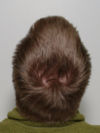
Cowlick
Encyclopedia

- See also hair whorlHair whorlA hair whorl is a patch of hair growing in the opposite direction of the rest of the hair. Hair whorls occur in most hairy animals, on the body as well as on the head. Hair whorls, also known as crowns, swirls, trichoglyphs, or cowlicks, can be either clockwise or counterclockwise in direction of...
.
A cowlick is a section of hair that stands straight up or lies at an angle at odds with the style in which the rest of an individual's hair is worn. Cowlicks appear when the growth direction of the hair
Hair
Hair is a filamentous biomaterial, that grows from follicles found in the dermis. Found exclusively in mammals, hair is one of the defining characteristics of the mammalian class....
forms a spiral pattern. The term "cowlick" originates from the domestic bovine's habit of licking its young, which results in a swirling pattern in the hair. The most common site of a human cowlick is in the crown, but they can show up anywhere. They also sometimes appear in the front and back of the head.
The term cowlick dates from the late 16th century, when Richard Haydocke used it in his translation of Lomazzo
Gian Paolo Lomazzo
Gian Paolo Lomazzo was an Italian painter, more remembered for his writings on art theory, belonging to the second generation that produced Mannerism in Italian art and architecture.Gian Paolo Lomazzo was born in Milan from a family emigrated from the town of Lomazzo...
: "The lockes or plaine feakes of haire called cow-lickes, are made turning upwards."
Characteristics
Hair on the back of the head usually grows in a circular flattened pattern from a central point, but this can also occur on facial hair in men. The definition of a whorl is hairs that rotate round an axis. The point where we find the hair whorl is the spot where the hair changes direction. On top of the head hair grows to the front, on the back of the head it grows towards the nape and hair grows to the left and right side of the head on the sides of the head. The hair whorl can be in the center of the head but it can also be located to the left or right side of the head. In the very center of the whorl some scalp will be visible because the hair lies flat.People tend to have at least two hair whorls with one being dominant and clearly visible while the other is less obvious. In the center of the hair whorl you can see the hairs protruding from the scalp. When combed against the grain of the hair, the hair in the center of the cowlick will stand up straight. When left too long the cowlick will create a flat spot, when left too short it will stand up.
Cowlicks are more obvious in straight, thick hair. In people with straight coarse hair the scalp will show in the center of the whorl because the light penetrates to the scalp. Both men and women have cowlicks, which can be covered by longer hair so the whorl is not visible.
One theory is that a cowlick stems from a circular arrangement of the collagen fibers in the cranial fascia of the area of the cowlick, this arrangement is different from the normal, straight pattern.
Management
Many people find cowlicks to be irritating, as they often conflict with the desired hairstyle. There are several methods of taming an unruly cowlick. For most people, a combination of the right hairstyle, length, product used, and styling technique can overcome the appearance. For people more serious about cowlick management, more drastic measures may be used. ElectrologyElectrology
Electrology is the practice of electrical epilation to permanently remove human hair. The actual process of removing the hair is referred to as electrolysis.-Overview:...
, waxing
Waxing
Waxing is a method of semi-permanent hair removal which removes the hair from the root. New hair will not grow back in the previously waxed area for two to eight weeks, although some people will start to see regrowth in only a week. Almost any area of the body can be waxed, including eyebrows,...
, and even cosmetic surgery can be used to more permanently correct the cowlick.

